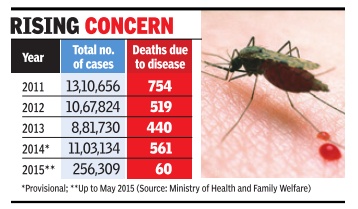Malaria: India
This is a collection of articles archived for the excellence of their content. Readers will be able to edit existing articles and post new articles directly |
Contents |
Malaria: India
Half the world at risk of malaria: WHO Of 243M Cases Across Globe In 2009, 863000 Died; Africa Accounts For 90% Of Infections
The news from the frontline is mixed on World Malaria Day today. While the UN affiliated World Health Organisation (WHO) and several private agencies are cautiously optimistic because of recent decline in reported malaria cases and an increased flow of funds for fighting malaria, others, including the leading health journal Lancet are pointing at the looming clouds of drug resistance and lack of suitable vaccine for this ancient killer disease.
Malaria, along with tuberculosis, continues to be one of the world’s most lethal diseases with half the world’s population — about 3.3 billion people — at risk from it, according to the latest World Malaria Report 2009, released by WHO last December. Over 243 million confirmed cases of malaria were reported from across the world, of which an estimated 863,000 died. The biggest burden of malaria is borne by Africa with nearly 90% of cases, most being children below 5 years.
In India, while there has been proportional reduction in the number of cases, the numbers are still huge. From over 2 million reported cases in 2000, confirmed malaria cases dropped to about 1.51 million in 2007, but then showed an upward tick in the next two years to reach 1.53 million in 2009, according to provisional estimates of National Vector Borne Diseases Control Programme of the health ministry.
Experts believe that these are gross underestimates because the reach of testing facilities is limited and large numbers are going unreported.
In the World Malaria Report, WHO director general Margaret Chan struck an optimistic note saying that global funding for fighting malaria had jumped from a commitment of $300 million in 2003 to $1.7 billion in 2009. As a result, coverage with insecticide treated nets (ITN) increased from 17% to 31% while population covered by indoor residual spraying of insecticide increased from 14 million to 59 million. Testing for malaria and treatment with the new artemisinin combination therapy (ACT) too has increased substantially.
In 2006, WHO issued new guidelines for tackling malaria that include mandatory testing before prescribing drugs. This is to prevent the growing threat of resistance of the malarial parasite to these drugs if given indiscriminately. Quinine based drugs have already gone out of favor because of widespread resistance to it.
In India too, one variety of malarial parasite was found to have developed resistance to chloroquine in 117 highly endemic districts of 7 North Eastern states and Andhra Pradesh, Chhatisgarh, Jharkhand, Madhya Pradesh and Orissa.
As the resilient malarial parasite battles it out with medical science across the world in a do or die battle, there are some ominous signs on the horizon. Starting with studies in Cambodia, and then from several pockets in other parts of the world, resistance to the new artemisinin based drugs has been reported. According to an editorial in Friday’s edition of Lancet, “There is currently no new drug class for treatment in advanced development”. In other words, if resistance to artemisinin spreads, like it did for chloroquine, the global fight against malaria would be lost.
Vivax: Changes and increase
The Times of India, Jul 31 2015

`Malaria's P. vivax strain threat to India'
Sushmi Dey
A particular strain of malaria parasite, which was believed to be less fatal, is now causing high disease burden, latest assessment by the World Health Organization shows. While asking India to strengthen its strategy for elimination of malaria, the agency said countries need to focus more on P.vivax, which was so far known as less fatal but as the latest data shows the risk from the parasite is increasing.
India, in particular has witnessed a huge growth in the number of malaria cases due to P.vivax. In 2013, there were an estimated 15.8 million symptomatic cases of P.vivax malaria globally . Out of this, two-thirds occurred in the south-east Asia region which includes India, according to a latest WHO report on control and elimination of P.vivax malaria.
Though, the report doesn't provide specific number of P.vivax cases found in India, WHO said in a statement that India is a major contributor to the cases found in south-east Asia.
Separately , the Union health ministry's assessment under the National Vector Borne Disease Control Programme shows that there is a slight dip in the malaria cases due to P. falciparum parasite, known to be more fatal. According to a health ministry official, over 50% of total malaria cases in India are triggered by P.vivax. “Our efforts so far focused on the most deadly P.falciparum malaria. We need to now broaden our strategy to include targeted interventions for P.vivax malaria, which is contributing to a large proportion of global malaria burden, mainly in the WHO south-east Asia region,“ said WHO regional director Poonam Khetrapal Singh. WHO is hosting a global malaria meet in New Delhi to address the rising threat of P.vivax.
Incidence of Malaria
2016
4,443 malaria cases in Mewat since June – Sept 2016
A mid the din and hurt sentiments that the Haryana government's biryani policing generated in Mewat, a malaria threat sweeping through the district has gone virtually unnoticed and, going by the government's own figures, unchecked.
Since June, Mewat has recorded 4,443 cases of malaria, which accounts for two-thirds of the 6,695 cases reported across Haryana.Around 90% of the posts in Mewat's health department lying vacant. “The reason why we are unable to tackle this menace is because there are hardly any medical resources,“ said a health department official.